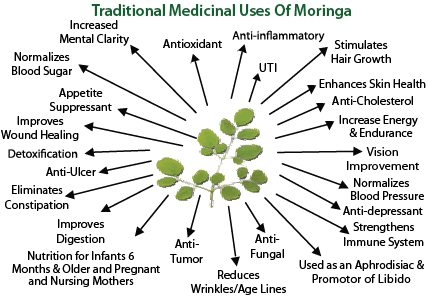
About Moringa
Every part of moringa (also known as moringa oleifera), including the seeds and roots can be consumed and are very useful in treating many diseases like lung diseases, hypertension, chest infections, everyday aches and pains as well as skin infections.
The World Health Organization (WHO) has undertaken scientific researches on the moringa plant, and has come to the conclusion that it is extremely nutritional and medicinal. The benefits have also been documented in some medical and nutritional journals as well.
Moringa Oleifera is among the popular power greens such as wheat grass, chlorella and spirulina. Moringa is rich in minerals like potassium, iron, calcium, and sulfur. It has B vitamins and 10 amino acids. Its nutritional profile is competitive with any beneficial plant on the planet. For example:
Nutritional Information
· One half cup of cooked leaves will meet your daily recommendation for Vitamins A and C
· One half cup of pods (raw) will supply your Vitamin C requirement for a day
· One ounce of raw leaves contains the recommended daily amount of Vitamin C
· Ounce per ounce it contains 6 to 7 times the amount of Vitamin C in orange juice
· Moringa leaves contain 3 to 5 times more beta-carotene than carrots
· 3 oz of moringa powder contains more than 10 times the recommended daily amount of Vitamin E
· Ounce per ounce Moringa leaves contain over 3 times the iron as found in spinach or roast beef
· Moringa leaves contain 3 times the amount of potassium as bananas
· Ounce per ounce Moringa leaves contain 4 times the amount of calcium found in milk
It is a very hardy plant that can grow in very dry climates, needing only 10 inches of water a year. With proper care and watering they can grow up to 16 feet in a year. It is recommended however, to cut it back and keep it short and bushy for ease of harvesting the leaves and pods.
The seeds can be eaten raw similar to edamame, the pods can be cooked much like okra; the leaves can be eaten raw in a salad, or cooked like collards or other greens. The leaves can be dried and powdered and used in drinks or teas.
So it has a myriad of ways that it can be consumed and enjoyed.
The flowers can be used as a natural pesticide, as insects and other pests are repelledby the flower essence, yet they are not harmful at all for human consumption. Seed extract is also used to purify water.
 |
|||
 |
A Unique Tool Provided By Nature
|
||
Benefits of Moringa
|
|||

